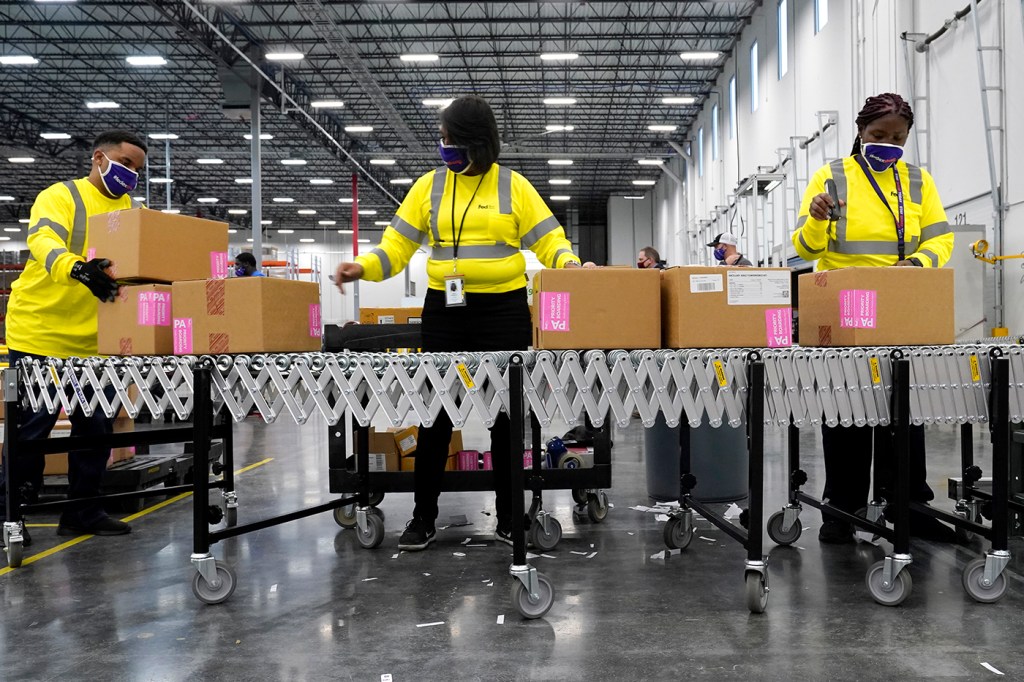Businesses like Amazon and Nike could rescue the vaccine rollout

With the COVID-19 vaccine rollout lagging far behind schedule, a Northeastern professor offers this advice to president-elect Joe Biden: Hire a supply chain expert from Amazon, Nike, or another company that manages complex inventory by overseeing all phases from end to end.
A wide range of businesses have developed a set of transferable skills and tools that could help the federal government to meet its goal of vaccinating 80 percent of the United States population, says Nada Sanders, distinguished professor of supply chain management at Northeastern.
“Every day, Nike is thinking about how much inventory they have, how they’re promoting it, how they’re selling it, who are the customers,” says Sanders. “They’re watching and communicating in real time with their production facilities and their distributors, which is the level of transparency that must be applied to vaccines—an especially complex product with stringent handling requirements and shelf life.”

Raj Echambadi (left) and Nada Sanders say that U.S. businesses should be able to help the vaccination rollout. Photos by Matthew Modoono and Adam Glanzman/Northeastern University
The government has fallen short of its aim to vaccinate 20 million people by the end of 2020. As of Jan. 8, only 6.7 million people had been inoculated.
In hope of increasing vaccinations, Biden plans to release virtually all of the available doses in a change of strategy from the Trump administration, which has been holding vaccines to ensure secondary doses are available.
Another measure that should be taken, says Sanders, is to focus on improving the supply chain.
“I would describe it as extremely poor, unplanned, and completely in violation of even the basic tenets of supply-chain management,” Sanders says of the vaccination rollout. She notes that similar problems emerged when the government distributed personal protective equipment and COVID-19 test kits in the early days of the pandemic. “The rudimentary tactics continue to be an issue.”
Raj Echambadi, Dunton Family Dean of the D’Amore-McKim School of Business, describes the vaccine rollout as “likely the largest global public-health initiative in modern times.” U.S. businesses have always assisted with such large-scale mobilizations to help society, he says.
“They will definitely help governments because COVID-19 has been a public health crisis and an economic crisis rolled into one,” Echambadi says. “Businesses can lend their expertise in managing complex end-to-end supply chains to help governments develop a comprehensive vaccination strategy.”
The mistake the government has made, says Sanders, has been its utilization of an “over the wall approach” to supply chain management—equivalent to tossing the vaccines over an imaginary wall and leaving it to the states to figure out how to distribute them.
“No coordination, no communication, no transparency—that’s what we mean by ‘over the wall,’” she says.
Instead, she says, the government should take a “backward scheduling” approach to the supply chain—a form of reverse-engineering based on the number of vaccinations that must be provided over a given period of time. More than 260 million people in the U.S. will need vaccines in order to achieve herd immunity.
Working backward from that number enables the government to manage operations with vaccine manufacturers, purchase the products required to transport and distribute the vaccines, and establish a reliable scheduling system for vaccinations.
Complicating the logistical issues is the necessity for refrigeration of the vaccines. The Pfizer vaccine must be transported in a thermal shipping container with dry ice at a temperature between minus-112 and minus-76 degrees Fahrenheit; the Moderna vaccine is delivered frozen at a temperature between minus-13 and five degrees Fahrenheit.
That’s an area where industry expertise could be helpful, says Sanders, as the “cold chain”—which is routinely used in food and pharmaceutical industries—has its own challenges. Even dairy manufacturers, she notes, deal with their own “cold chain” issues as they move perishable dairy products like milk and cheeses from farm to factory to store within a limited period of time.
“You have to make sure that the item is handled correctly and that there is integrity throughout the handling process,” says Sanders, who has written several books on supply chain management.
Allowances must be made for different regions of the U.S.—providing vaccinations in North Dakota will be different from treating people in New York City, for example. Additionally, the system must account for the likelihood of disruptions, including snowstorms, truck breakdowns, an incapacitation of medical personnel, a shortage of vials, a spoilage of vaccines, and other potential issues.
Sanders and Echambadi agree that the government may be able to create an effective and efficient supply chain based on any number of models in the business world, including Walmart, Apple, and eBay.
“Before the pandemic, I was standing in the supply chain headquarters of a big company in Massachusetts, in what almost looked like a computerized war room,” she says. “You could watch the movement of various products, you could see the inventories building up, you could watch the managers monitoring everything that was going on. That’s what needs to be done with the vaccines.”
How quickly can an end-to-end supply chain be created by the new administration after Biden is inaugurated Jan. 20?
“The first step will require a complete inventory mapping, analogous to coming into a messy house and taking an inventory to see exactly what you’ve got and where it is located,” Sanders says. “I don’t think that can be done in a day or two. The more bottlenecks they find in the system, the harder it’s going to be.”
For media inquiries, please contact Jessica Hair at j.hair@northeastern.edu or 617-373-5718.






